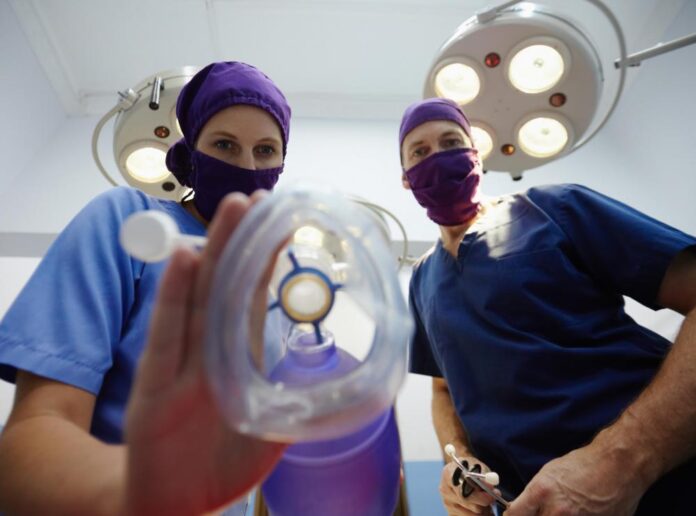When we think about greenhouse gas emissions our first image is of smokestacks belching out tons of carbon dioxide (CO2) daily, or oil and natural gas fields lit up by the flaring of methane (CH4). We don’t usually think about anesthetics, puffers and metered-dose inhalers. But we should.
Anesthetics are Potent Greenhouse Gas Emissions Producers
Inhaled anesthetics such as nitrous oxide (N2O), and halogenated gasses largely remain unmetabolized by patients during surgical procedures. Post-surgically they are exhaled where they enter the atmosphere in the operating room, a danger to medical staff, and then escape to the outside air where their greenhouse gas emission properties contribute to global warming. But that’s not all, halogenated gasses made up of chlorofluorocarbons or fluorinated hydrocarbons also damage the ozone layer.
CO2 is the greenhouse gas of headlines followed by CH4. Why? The former is produced by almost every modern human activity and it persists in the atmosphere for thousands of years.
CH4 lasts in the atmosphere on average a little more than a decade but its heat-absorbing capacity as a greenhouse gas is as much as 80 times greater than CO2, which is why the recent IPCC reports have stressed the need to tackle CH4 leaking natural gas and oil wells as an immediate priority.
Nitrous oxide (N2O) also is emitted by human industrial processes contributing to atmospheric warming. But as an anesthetic gas in use for more than 150 years, it has 298 times the greenhouse gas impact of CO2 and persists in the atmosphere for more than a century.
Finally, we have the halogenated gasses: chlorofluorocarbons (CFCs), hydrofluorocarbons (HFCs), hydrochlorofluorocarbons (HCFCs), and perfluorocarbons (PFCs) with greenhouse gas properties thousands to tens of thousands of times more potent than CO2. These go by the names Halothane, Enflurane, Isoflurane, Sevoflurane, and Desflurane. How long do they persist in the atmosphere? It ranges from Sevoflurane at 1.2 years, to Isoflurane’s 3.6, and Desflurane’s 10.
A typical mid-sized US hospital, of which there were 7,380 in 2022, goes through 1,000 litres of these chemicals annually. In the journal Anesthesia Progress, a 2012 article estimated the equivalent greenhouse gas emissions contribution from these anesthetics equal to 4,780 tons of CO2 per year. That amounts to 35.27 million tons in total or the emissions equivalent of 8.8 million cars annually.
There are anesthetic gas capture technologies that can be installed in operating rooms. These are designed to extract the gasses before they escape to the outside. CONTRAfluran is one of these systems that separate, sterilize and store recaptured Desflurane and Sevoflurane from within the operating room environment allowing the hospital to sell the anesthetics back to their pharmaceutical producers. Another company Blue-Zone Technologies has produced Deltasorb and Centralsob canister systems that attach to anesthetic administering equipment in the operating room to limit emissions.
Is It Fair to Make Anesthetics a Target for Environmental Activism?
An article appearing in a 2017 edition of The Lancet, asks the above question. It notes that the overall benefit of anesthetic gasses needs to be in the environmental calculation. It also points to other areas of medical practice that need scrutiny in looking at the profession’s environmental impact. The article has produced ten examples of where medicine can make better choices. These include:
- Prescribing antibiotics appropriately and getting patients to use them correctly.
- Reducing variation in medical practice that leads to unnecessary testing.
- Getting treatments or procedures right the first time.
- Encouraging patients to consume less alcohol and meat, and exercise more.
- Helping businesses and industry to make quality improvements to work environments and getting them to adopt lean working practices.
- Avoiding intravenous drug usage by using oral alternatives since the sterilization requirement contributes to a larger carbon footprint.
- Reducing, reusing, recycling, and disposing of medical and other waste correctly.
- Collaborating with other facilities to do high-volume item bulk purchasing to reduce transport emissions.
- Encouraging patients to take responsibility for their own health.
- Discussing medical treatment and resuscitation decisions with patients and their families at an early stage, to ensure resources are not being used that are not wanted.
In Part 2 on this topic, we look at inhalers and their global warming potential.
















